What Is an Email Blast? Definition, Examples, and Best Practices
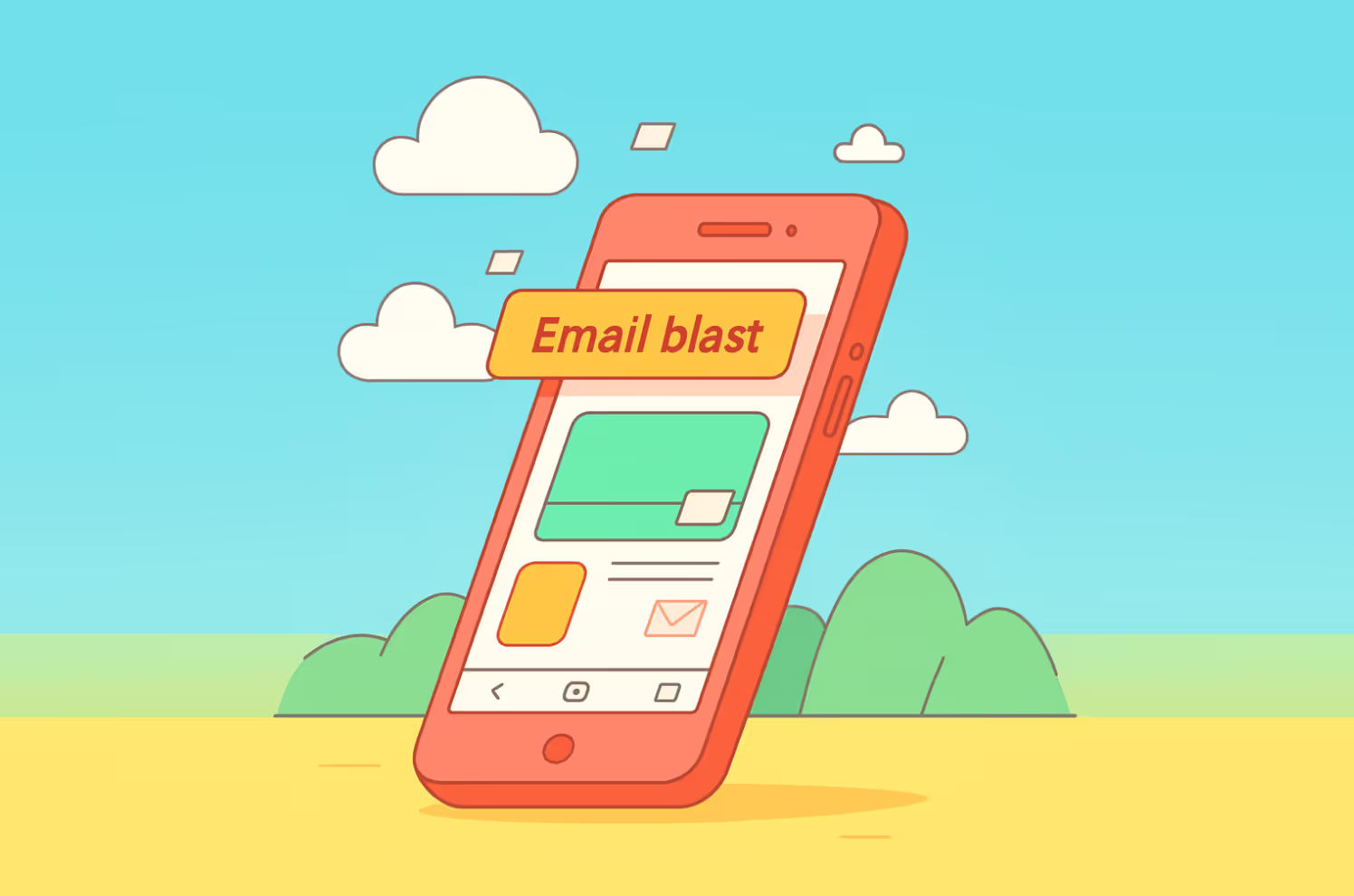
You’ve probably heard the term “email blast” before. Some people roll their eyes at it, calling it old-fashioned, while others still lean on it as a fast way to get the word out.
What is an email blast? At its core, an email blast is simply one email sent to a large group of people at the same time.
Who uses it? Think marketers announcing a new product, nonprofits spreading awareness, educators reminding students, or small businesses promoting a seasonal sale. The idea is speed and reach, not personalization. Everyone on the list gets the same message, unlike automated workflows or segmented campaigns that adapt to user behavior.
Over the years, email blasts have shifted from being the go-to strategy to more of a supporting role. These days, they’re best for quick announcements, time-sensitive deals, or urgent updates. Knowing the email blast definition helps you see when it’s the right fit and when smarter targeting might work better.
Do Email Blasts Still Work Today?
If you have ever wondered whether email blasts really work, the numbers help put things into perspective. While they remain useful for reaching a wide audience quickly, the data shows that engagement is stronger when emails are more targeted.
Recent studies highlight a few key points:
- The average email open rate across industries sits around 42 percent in 2025.
- Segmented campaigns see much better performance, with open rates about 14 percent higher and click-through rates more than double compared to broad blasts.
- Triggered or automated emails also stand out, often earning 70 percent higher open rates and over 150 percent more clicks.
- In education, relevant blasts still do well, averaging between 35 and 45 percent open rates.
What this tells us is clear. Email blasts are still effective for speed and reach, but they cannot match the engagement of segmentation or automation. The smartest move is to use blasts for time-sensitive updates and pair them with targeted strategies for long-term results.
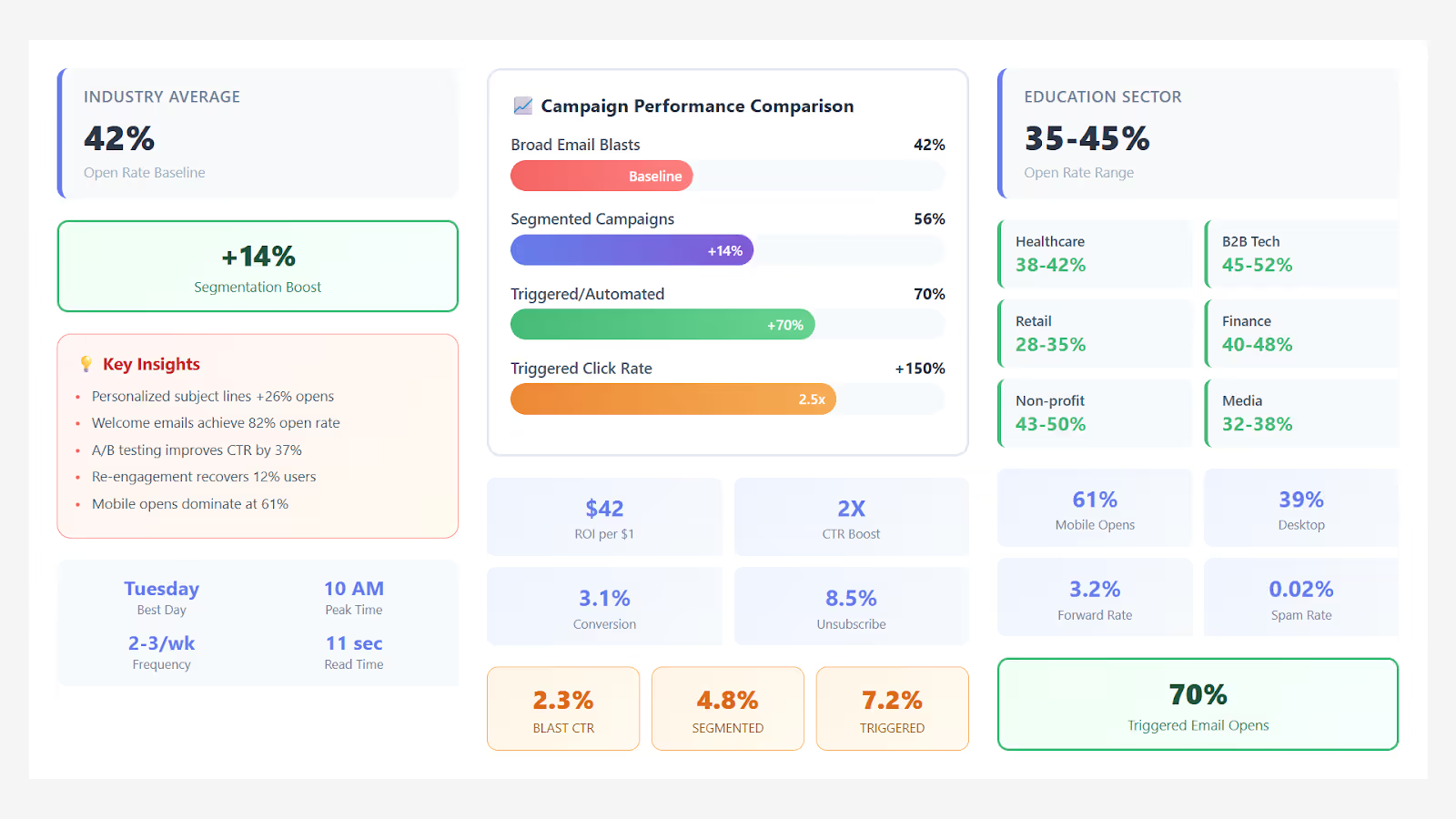
You should also read our article about 9 Free Email Providers for Personal and Business Use.
What’s the Recommended Word Count for an Email Blast?
There isn’t a single perfect number, but most effective blasts fall in the range of 50 to 200 words. That’s enough space to share the core message without overwhelming readers.
The right length depends on your goal. A promotional blast often works best when it’s short and punchy, leading readers directly to a call-to-action. An informational blast, like a nonprofit update or event announcement, can stretch a little longer if it adds value.
More important than hitting a word count is keeping things clear. A well-structured design, scannable text, and a single clear call-to-action will do more for engagement than an exact number of words ever will.
Read also: 10 Email Etiquette Examples for Professional Communication
Examples of Email Blasts in Action
Email blasts may look simple on the surface, but how they’re used makes all the difference. Let’s look at three common scenarios where blasts are still effective.
Promotional Sales Emails in E-commerce
Retail and e-commerce brands often use blasts to announce flash sales or seasonal discounts. A single, well-timed email to the entire customer list can quickly generate traffic and sales. For example, “40% Off All Winter Styles – Today Only” works because it’s clear, urgent, and focused on one offer.
Deadline Reminders in Education
Universities and training programs often send deadline reminders through blasts. These could be for course registration, exam schedules, or tuition payments. The goal is simple: make sure no student misses an important date by putting the same message in everyone’s inbox.
Fundraising Pushes in Nonprofits
Nonprofits rely on blasts during donation drives. A message that combines urgency with storytelling, such as highlighting how contributions will directly impact a cause, can encourage large numbers of supporters to act quickly.
You should also take a look at our step-by-step guide on AI Sales Agents: From Sequences to Conversations
Good vs Bad Email Blasts
Not every email blast delivers the same results. The real difference comes down to clarity, focus, and whether the message feels helpful or overwhelming. Let’s look at this through the lens of education, where blasts are commonly used.
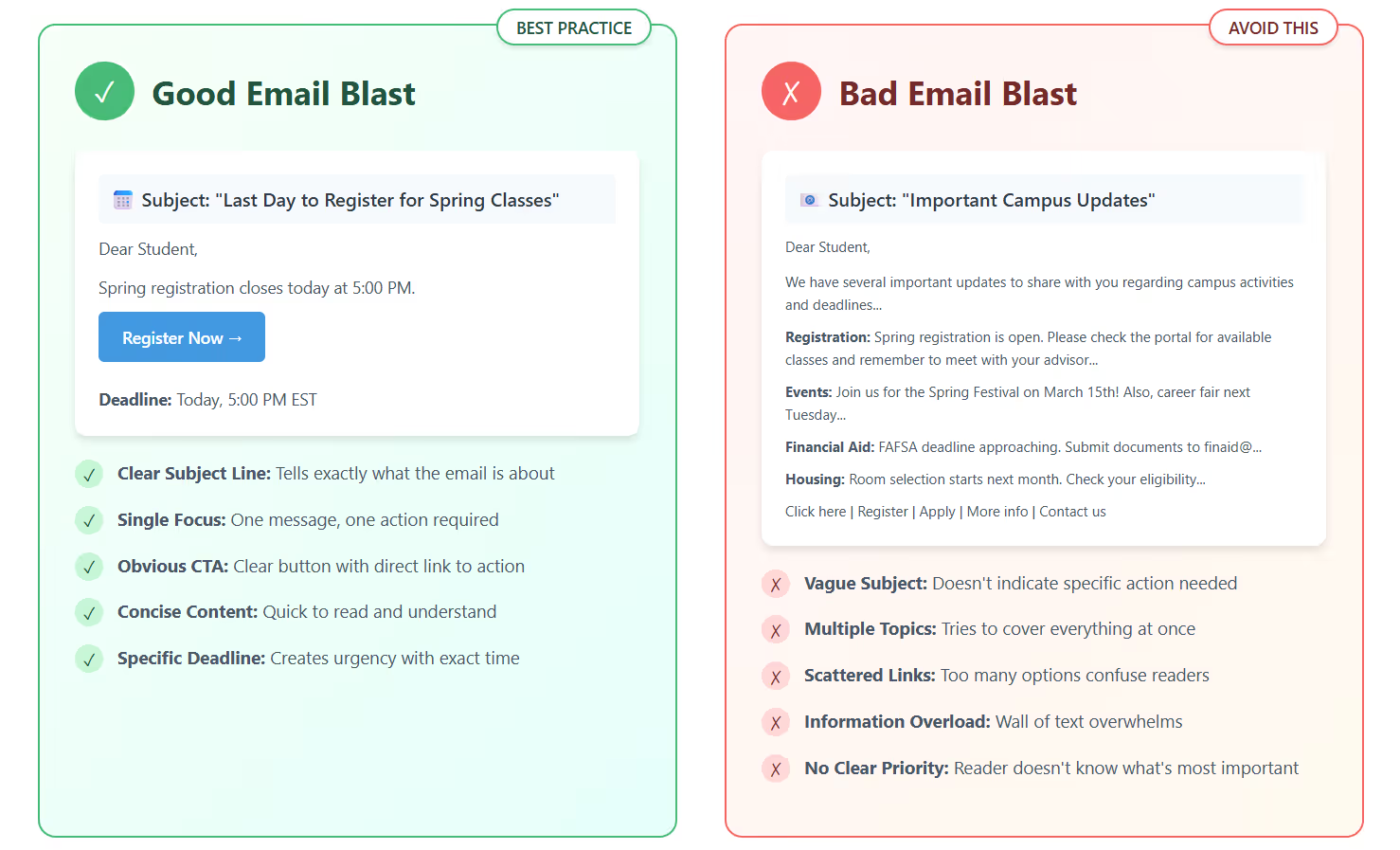
What Makes a Good Email Blast
A good email blast gets straight to the point and makes the next step crystal clear. In education, this might look like a university sending a reminder about an upcoming registration deadline. The subject line could read “Last Day to Register for Spring Classes” with the body text keeping it simple: a short reminder, a single link to the registration portal, and a clear deadline. Students know exactly what’s expected, and they can act in seconds.
What Makes a Bad Email Blast
A bad email blast often tries to do too much at once. Imagine a college sending a single message that combines registration deadlines, campus event promotions, financial aid reminders, and housing updates all in one.
The subject line might be vague, the text crowded with paragraphs, and links scattered everywhere. Instead of helping students, this overload of information risks confusing them or worse, causing them to ignore the email entirely.
We have also written a guide on 25+ Professional Meeting Request Email Templates.
How to Run an Email Blast Successfully?
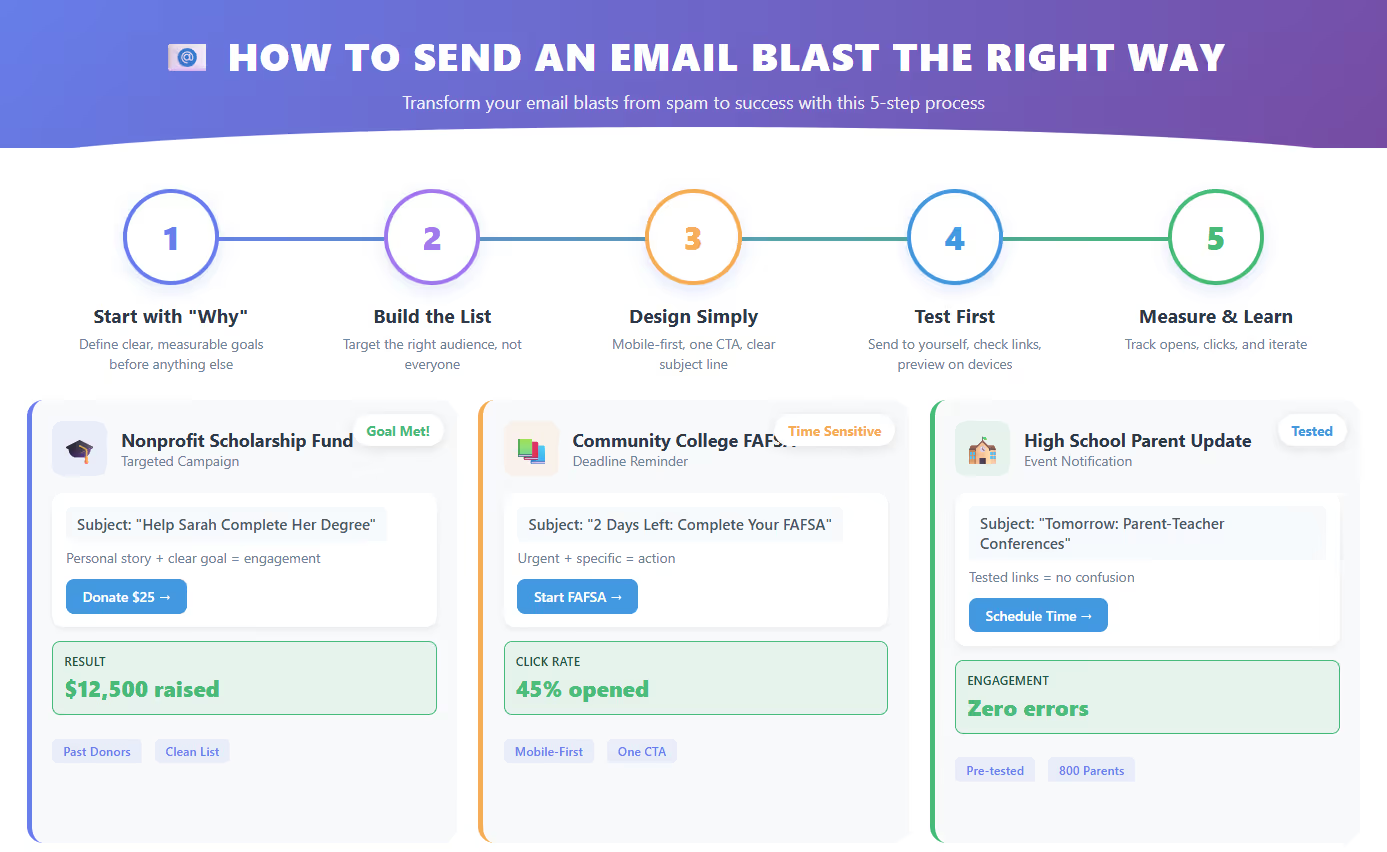
An email blast involves more than simply pressing the send button. The difference between one that works and one that flops comes down to planning, execution, and follow-up. Let’s break it down in a way that feels more like a real-life story than a manual.
First, start with the “why.” A nonprofit might set a clear goal like raising $10,000 for a scholarship fund. Having that purpose shapes everything else. Next comes the list. Instead of blasting every contact, the nonprofit builds a clean list of past donors who care about student success.
Then comes design. Think of a community college reminding students about FAFSA deadlines. The email has a short subject line like “2 Days Left: Complete Your FAFSA”, one call-to-action button, and formatting that looks good on mobile since most students will read it on their phones.
Testing is another step many skip. A high school counselor might send a test version to themselves first, catching a broken link before it goes to 800 parents. That tiny step saves confusion later.
Finally, once the blast goes out, the real work begins: measuring. If only 20 percent of students clicked the FAFSA link, the college knows to tweak the subject line or timing next time.
In short, learning how to send an email blast well is less about being a tech expert and more about respecting your audience’s time. Clear goals, clean lists, simple design, and thoughtful follow-up are what turn a blast into results.
Best Practices for Email Blasts
Sending an email blast may sound easy, but making it effective takes some careful choices. The difference between a campaign that drives action and one that gets ignored usually comes down to following a few proven habits.
Keep Your Copy Natural and Clean
Simple wording, short sentences, and one clear call to action always perform better than long, cluttered text. Avoid phrases that sound too pushy or overly promotional since they can turn readers off or push your email into spam.
Segment Where You Can
Even if you are sending to a large group, adding a little segmentation helps. For example, a university might send a deadline reminder to current students and a slightly different one to alumni. Both messages cover the same update but speak directly to the audience.
Pay Attention to Timing and Frequency
Inbox fatigue is real. Sending too often can frustrate subscribers and lead to unsubscribes. A steady rhythm, such as weekly or monthly, works better than daily blasts. Testing mornings versus evenings, or weekdays versus weekends, helps you learn when your audience is most responsive.
Respect Legal Standards
Every blast should follow regulations like GDPR and CAN-SPAM. That means including an unsubscribe link, a physical address, and sending only to people who gave consent. Beyond the legal side, it shows respect for your audience’s choice to stay connected.
Track Results and Refine
Data tells the story. If opens are strong but clicks are low, your message may not be compelling enough. If unsubscribes spike, it may be time to adjust your frequency. Treat every blast as feedback for the next one.
See also: What Is High-Ticket Sales? Definition, Strategy, and Examples
OutSales.ai: Taking Email Blasts to the Next Level
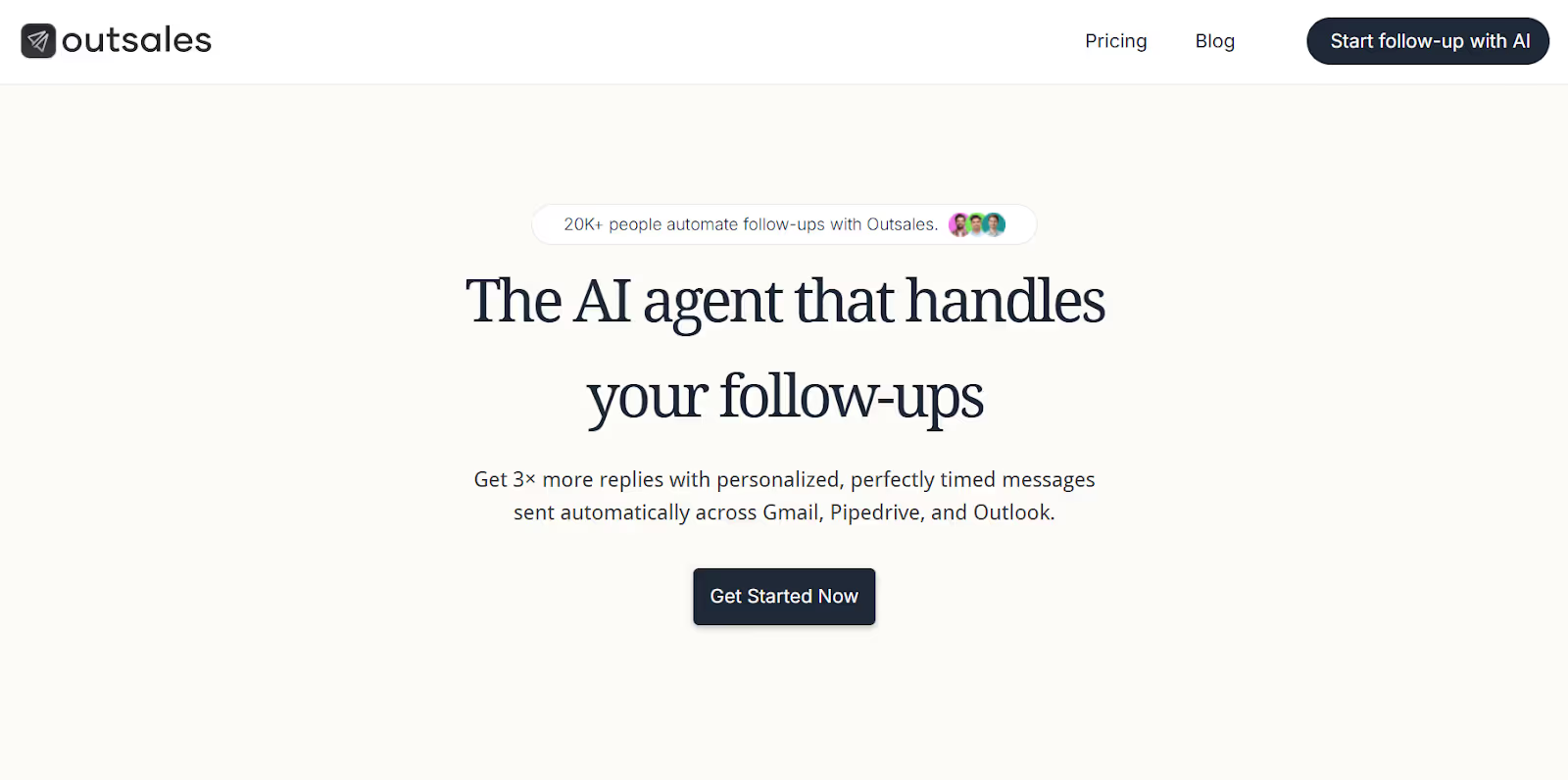
Traditional email blasts are great for speed and reach, but they often fall short on personalization. That’s where OutSales.ai steps in. Instead of sending the same generic message to thousands of inboxes, it uses artificial intelligence to make each email feel tailored while still handling high volumes.
Here’s how OutSales.ai transforms the concept of an email blast:
- AI-driven personalization: Reads past conversations, CRM data, and call notes to adjust tone and messaging for each recipient.
- Automated follow-ups: Sends sequenced replies until someone responds, so you never lose leads in the shuffle.
- Scalable outreach: Handles large sending volumes but keeps engagement high by avoiding “copy-paste” style emails.
- Reply intelligence: Scores intent in email threads and prioritizes warm leads for your team.
In practice, this means OutSales.ai lets you keep the efficiency of a blast while delivering the kind of one-to-one personalization that segmented campaigns promise. For teams that need both volume and authenticity, it makes a strong case as a smarter alternative to traditional blasting tools.
Verdict
At the end of the day, an email blast still has its place. It’s fast, cost-effective, and great for time-sensitive updates. But its biggest limitation has always been personalization. That’s why the smartest approach today is not to abandon blasts but to evolve them.
Tools like OutSales.ai make that possible. They give you the speed and scale of a blast while layering in personalization, automation, and intelligent follow-ups. The result is outreach that feels less like a mass message and more like a genuine conversation.
If you need reach, use blasts strategically. If you want results, pair them with smarter tools that keep every recipient engaged.
If you found this useful, you’ll want to check out our full guide on How to See If Someone Read Your Email.




.avif)



.svg)

